Physical Address
304 North Cardinal St.
Dorchester Center, MA 02124
Surgical positioning aims to optimize access to surgical pathologies, avoid secondary injuries, and decrease operator fatigue. Commonly used patient positions for cranial and spine cases are discussed.
Neuronavigation helps to improve surgical accuracy and decrease injury to critical neurovascular structures. It is an indispensable tool for minimally invasive “keyhole” surgeries on suitable lesions.
Proper selection and use of available surgical tools enhances a surgeon's ability to treat various neurosurgical pathologic conditions effectively and safely. Surgical tools commonly employed in neurosurgical cases are discussed.
The goal of a craniotomy is to provide sufficient working space and direct access to a site of surgical pathology while avoiding injury to the surrounding neurovascular tissue during the process. Guiding principles are discussed on skin flap design, and technical “tricks” are discussed to facilitate safe craniotomy.
Wound closure requires meticulous attention to decrease wound dehiscence and improve the cosmetic result.
Modern neurosurgery as a well-established surgical subspecialty has made saltatory progress beginning in the late 19th century. This advancement is made possible by our deepening understandings of neural anatomy and physiology, continued innovations in surgical tools and imaging modalities, and critical evaluations of patient outcome–centered results. Today we are able to effectively treat many neurologic disorders, some of which were off limits not so long ago. Although ample effort is being devoted to pursue cutting-edge methods to treat ailments of the nervous system, a solid grasp of the basics of established neurosurgical techniques is a prerequisite for a surgeon to be able to safely and effectively treat a patient encountered in a neurosurgical practice.
Positioning of the patient is the first step of any surgical procedure. Careful preoperative planning should include consideration of operative patient position, because optimal position facilitates access to the surgical pathology, decreases untoward complications, and minimizes operator fatigue. Neurophysiologic monitoring is increasingly used to document preexisting deficits and identify postpositional or intraoperative deficits, some of which can be resolved by prompt reposition.
For cranial pathologies, depending on where the lesion is and what surgical approach is selected to get to the lesion, the patient can be positioned supine, lateral, prone, or sitting. The head position is chosen to gain the most direct access to the site of pathology without the need to traverse critical brain structures, to decrease obstruction of view from other portions of the brain by using gravity and minimize the need of brain retraction, to avoid venous outflow obstruction due to excessive neck turning and compression of the internal jugular vein, leading to brain swelling, and to avoid excessive neck flexion causing airway obstruction or spinal cord injury in patients with baseline cervical stenosis.
The body should be secured with multiple tapes and belts to avoid body shift during the surgery when the bed position needs to be adjusted to better visualize the site of pathology. We have developed a custom-made operating table and side rail–attached padded bolsters to provide extra support. A “tilt test” is performed before draping to ensure that the body is secured when the bed is moved in all directions, in anticipation of what may be needed during the procedure. The joint position of the patient should not be under tension, and bony surfaces at major joints should be padded; any contact areas between soft tissue and a hard surface that are under pressure (such as an IV connector on the arm or a Foley connector on the thigh) after final position should be padded with a cushion to avoid skin necrosis or peripheral neuropathy.
Surgical manipulation of the brain involves having the head secured to avoid sudden movement intraoperatively but also accessible so that the operator is not encumbered by the rest of the body or the surgical bed. Unique to neurosurgery, the head of the patient typically is placed beyond the surgical bed and secured in space with a head holder. The head is typically secured with a three-point holder with disposable pins, which is attached to the surgical bed (if intraoperative catheter angiogram is planned, a radiolucent head holder is used) ( Fig. 6.1 ). For young children with thin skulls and for cases when the head does not need to be moved much (such as trauma craniectomy or cerebral spinal fluid (CSF) diversion shunt placement), a horseshoe head holder is commonly used.
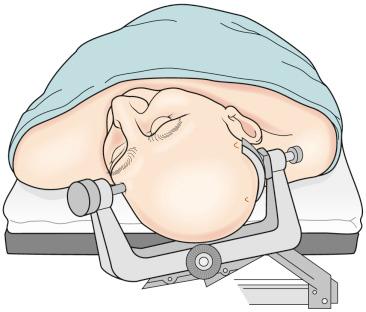
Preoperative CT scans and past neurosurgical history should be reviewed before applying the pinned head holder. A preexisting cranial defect, abnormally thinned skull from chronic hydrocephalus, the size of the frontal sinus and aeration of the mastoid, the presence of cranial hardware (such as an external ventricular drain, a shunt or stimulator device), and a bypass graft or potential donor blood vessel along the scalp (such as superficial temporal artery [STA] or occipital artery [OA]) should all be taken into consideration. If the pin punctures into a bony sinus, it can cause CSF leak; and if it penetrates a thin bone (such as the squamous temporal bone), it can cause skull fracture and epidural hemorrhage, even intracranial injury. The pins should be inserted along a plane of an imaginary head band to provide optimal mechanical support and to avoid the bulk of scalp muscles (such as the temporalis) to provide good purchase and avoid excessive bleeding after the pins are removed. The head holder is typically set to proper force (60–80 lb for adult patient and lesser value for pediatric patients depending on age ) and locked before it is attached to the bed. A rare but potentially hazardous event of a patient's slipping out of pins can be avoided by careful positioning of the pins on the skull, taking into account of the final position of the patient, applying proper force to the pins, and ensuring that all connections are secure.
A neuronavigation device and a brain retraction device can be attached to the head holder once the holder is connected and secured to the bed. All connections should be double-checked to ensure that there are no loose connections, because any potential unplanned movement of the head can translate into a large excursion under the microscope and can lead to potentially devastating injury to the brain structures during the procedure. The pins should not be very close to the planned surgical incision to facilitate sterile wound preparation and scalp closure. Occasionally the patient may have to be taken out of the pins at the end of the case in order to close the scalp without tension to the soft tissue.
If the patient is positioned prone or lateral on a horseshoe head holder, precautions should be taken to avoid pressure on the eyes or the ear.
The supine position is used for a large number of cranial procedures involving pathologies within the anterior and middle fossa. Shunt surgery also uses this position to get access to the ventricular system and the abdomen. If the lesion is along the midline, a straight supine position is used. If the lesion is along the Sylvian fissure, the head is usually turned 30 degrees to the contralateral side. For lesions near the opticocarotid cistern or the upper clival region, the head is turned 45 degrees to bring the abnormal structure in the direct line of sight of the surgeon under the microscope. If the lesion is near the anterior communicating artery, optic chiasm, anterior third ventricle, or in the temporal lobe, the head is typically turned 60 degrees with the zygoma brought to the highest point of the head. For patients with lesions near the tentorial notch or posterior temporal region, the head may need to be turned up to 70 degrees if the neck is flexible on preoperative exam if there is no marked asymmetry in the venous drainage system, and there is no evidence of elevated jugular venous pressure if it is monitored ( Fig. 6.2 ). For head turn more than 45 degrees, a supportive roll is placed behind the shoulder/trunk to avoid excessive neck turning. For obese patients or those with a short or stiff neck, a preoperative test may be necessary to ensure that the patient can tolerate the planned position.
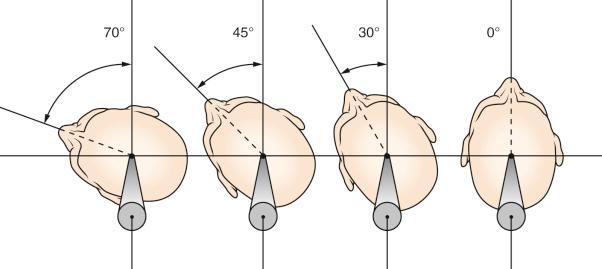
There are three axes of direction of movements during the head positioning: rotation in the axial plane, flexion and extension in the sagittal plane, and bending in the coronal plane ( Figs. 6.2–6.4 ). The goals of choosing a particular angle in the three axes are to bring the area of surgical interest into the direct line of sight of the surgeon under the microscope, to create maximum operative space by diminishing physical obstruction from the body habitus of the patient, to optimize venous outflow in the neck, and to minimize obscuring the effect from the surrounding brain structures using gravity. The patient's head is typically extended for basal lesions and flexed forward for posterior frontal or parietal lesions, and for intraventricular access ( Fig. 6.5 ).
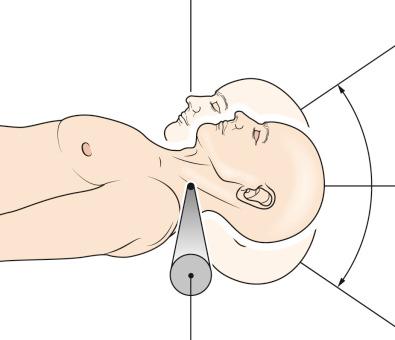
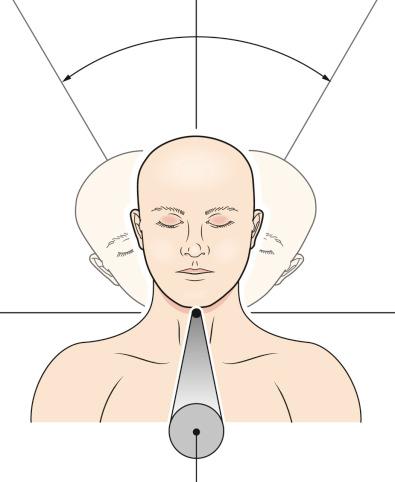
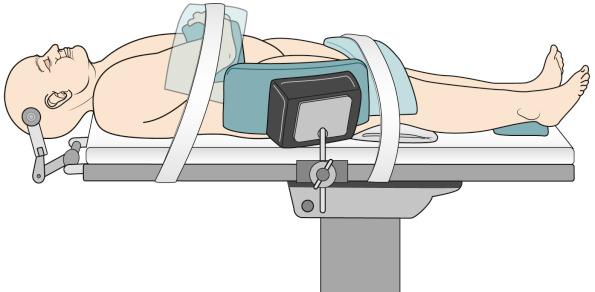
The lateral position is typically used for petrosal or posterior fossa lesions located away from the midline. For procedures longer than 4 hours, the arm can be placed off the bed in an arm sling, whereas an axillary roll can be placed under the dependent axilla for shorter cases. There are also three axes of potential movements in position as described previously. Excessive flexion in the sagittal plane should be avoided to prevent airway compromise (at least two fingers' breadth between the chin and the sternum). The head can be bent toward the floor in the coronal plane to open the space between the head and the shoulder and thereby provide maximum operative space. Rotating toward the surgeon in the axial plane helps with viewing of the brainstem, whereas rotating away from the surgeon facilitates visualization of the internal auditory canal (IAC) ( Fig. 6.6A–B ). Excessive flexion or rotation can occlude the vertebral artery if it is very dominant on one side, causing potential brainstem ischemia and injury, and should therefore be avoided.
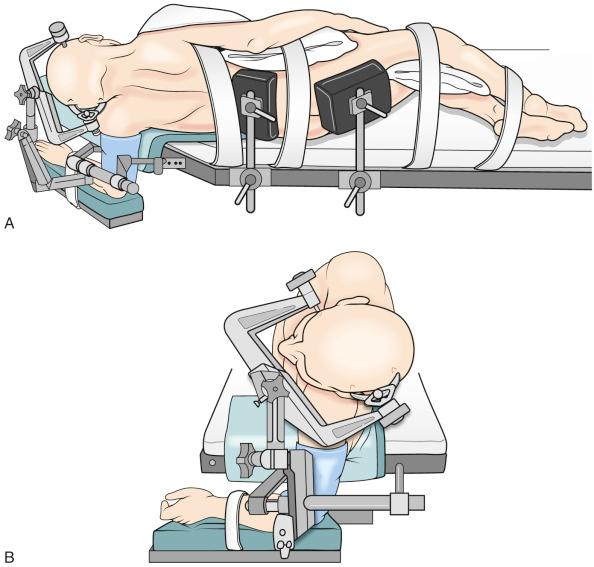
The prone position is used for lesions in the midline posterior fossa or the occipital region. A lateral position can also be used if there is laterality to the lesion with the dependent arm supported by an arm sling. The head is flexed (keep two fingers' breadth between the chin and the sternum) and lifted in the sagittal plane to make the line along the head and neck relatively flat, to open the cranial-cervical junction, and to provide an optimal visualization angle. The nipples and genitals should be free from direct pressure, and the head and feet are positioned higher than the heart to facilitate venous return ( Fig. 6.7 ).
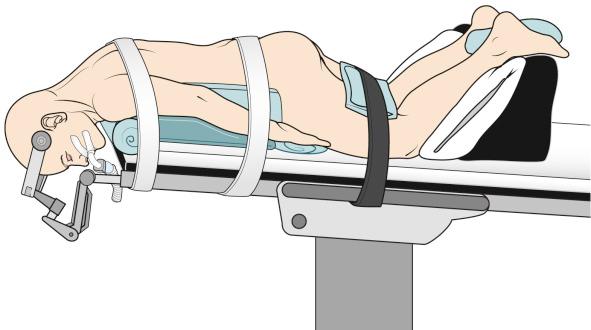
Become a Clinical Tree membership for Full access and enjoy Unlimited articles
If you are a member. Log in here